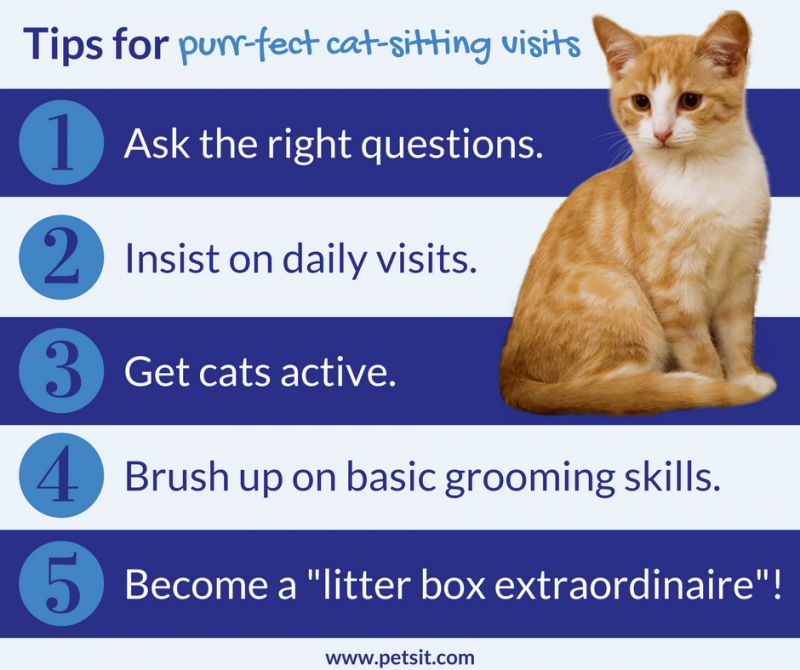5 Tips for Purr-fect Cat-Sitting Visits
As a professional pet sitter, you must go beyond litter scooping and kibble refills to offer the best possible feline care.
Beth Stultz | December 5, 2017 ![]()
![]()
![]()
![]()
![]()
This article was awarded the Certificate of Excellence from the Cat Writers Association and selected as the 2017 Muse Medallion winner for its category.![]() According to the 2017-2018 APPA National Pet Owners Survey, there are 94.2 million cats owned by 47.1 million households in the United States alone. U.S. pet owners are expected to spend $69.36 billion on their pets in 2017, with $6.11 billion of that total going to “other services,” a category which includes pet sitting. With these statistics, it’s likely that cat-sitting services make up a large part of your pet-sitting business, and many professional pet sitters are finding that transitioning to cats-only care is doable—and profitable.
According to the 2017-2018 APPA National Pet Owners Survey, there are 94.2 million cats owned by 47.1 million households in the United States alone. U.S. pet owners are expected to spend $69.36 billion on their pets in 2017, with $6.11 billion of that total going to “other services,” a category which includes pet sitting. With these statistics, it’s likely that cat-sitting services make up a large part of your pet-sitting business, and many professional pet sitters are finding that transitioning to cats-only care is doable—and profitable.

Dedicated cat parents spare no expense to ensure that their beloved kitties receive the best care possible. For professional pet sitters, keeping cat clients happy should be a top priority. While many may agree dog-sitting visits require more work, attention should also be given to providing quality cat-sitting services. Cat care goes beyond simply cleaning litter boxes and filling up food and water, and dedicated pet-care professionals can take extra steps to ensure they are providing the best possible cat care.
Take these steps to ensure your pet-sitting visits are the “cat’s meow”:
1. Ask the right questions.
The old proverb says “curiosity killed the cat,” but the truth is that asking questions can help save the cat—and you as the professional pet sitter—from a variety of issues. As with any pet you offer services for, you need to request information about the cat’s health and behavior before accepting a cat-sitting assignment. In addition to asking basic questions about a cat’s age, any ongoing or recent health conditions the cat may have, the client’s veterinarian preference and if the cat is spayed or neutered, also be sure to ask specific questions about the cat’s behavior that can help you determine if this is a cat-sitting assignment you’d like to accept and help you offer better care to the cat if you do take the assignment.
Questions you’ll want to ask of any potential cat client include:
- How does the cat react to your absence from home?
- Does your cat have any hiding places?
- How does your cat react to strangers?
- Are you aware of any reason we should approach your cat with caution?
- How does your cat react to other pets (e.g. any in-house grumbling or fighting)?
- Is there anything your cat potentially dislikes/reacts to (e.g. males, long hair, thunderstorms)?
You’ll also want to be sure to ask if the cat has ever bitten or scratched anyone—animal or human. Observing how the cat acts around her owners and around you during the initial consultation is not enough to go on, as many cats will behave differently when their owners are not around.
2. Insist on daily visits.
Imagine this: You arrive at a client’s home on a Tuesday evening to check on a cat for a family who is away on a 10-day cruise. At your first cat-sitting visit on Sunday night, the cat was understandably shy when you arrived, but playful by the time you ended your 30-minute visit. Today when you enter the home, however, you find the cat unresponsive and lying in puddles of vomit. You scoop up the cat and race to the nearest emergency veterinarian while trying to reach the owners who are somewhere on a ship in the Atlantic Ocean.
After a quick examination, the veterinarian determines this cat had developed a urinary obstruction and was unable to urinate. With this condition, his bladder had quickly become distended and kidney toxins were poisoning his blood stream. Once the veterinarian relieves the blockage and administers intravenous fluids, the cat is expected to make a full recovery after a long course of antibiotics—but the chance for survival would have been virtually nonexistent had you arrived at the home even an hour or two later.
While relieved, the pet owners have learned a valuable lesson—anything can happen when a pet is left alone. As a pet sitter you’ve also learned a valuable lesson: Cats need daily visits. Don’t let pet owners “bully” or persuade you into making exceptions to your policies regarding every day visits. Any type of pet-care arrangement, including the frequency of visits, should be included in your pet-sitting service contract and signed by the client.
In Elizabeth Xu’s article, “Do Cats Like to Be Alone?” on PetMD.com, cat behavior consultant Pam Johnson-Bennett also advises that cats should never be left for more than 24 hours—both because a caregiver can identify unexpected illness or injury and to keep a cat on her typical routine since cats are creatures of habit.
Anything can happen when pets are left alone—and cats are no exception. From potentially lethal ailments like urinary blockages to potential home damages from a cat accidentally loosening a water hose behind a washing machine, not checking on a cat daily while the owner is away can have costly—or tragic—consequences for your clients and your pet-sitting business.
3. Get cats active.
Feeding, watering and providing litter box maintenance may be the primary items on your cat-sitting to-do list, but don’t forget that cats need exercise as well. In Cat Wisdom 101’s Vet 101 article on cats and exercise, award-winning feline-only practitioner Dr. Letrisa Miller recommends 30 minutes of moderate activity per day for most cats. As a professional pet sitter, you can play an instrumental role in helping your cat clients achieve this activity-level goal during your cat-sitting visits. In addition to helping cats keep their muscles strong and maintain a healthy body weight, exercise also provides mental stimulation to keep their minds active and helps you increase your bond with the cats in your care.
Homemade toys such as knotted socks or cat-specific toys such as feather dancers are often big hits. For more ideas for easy-to-make homemade cat toys, check out this top-ten list from World’s Best Cat Litter™. Just remember to have the clients’ approval for any toys you may use. Also make sure you have a good understanding of the cat’s health history so you can adjust the level of play to the cat’s age, health and physical ability. You should always avoid rough play.
4. Brush up on your basic feline-grooming skills.
While more in-depth grooming needs should be left to professional groomers, you can enhance your cat-sitting visits by offering simple brushing or combing as add-on services. Regular grooming for cats is important to not only keep cats looking and feeling good, but to also get them comfortable with regular handling. Regular brushing or combing stimulates and conditions cats’ skin. It can also help prevent mats and control hairballs. It’s also a great bonding time for you and your kitty clients—and a bonus cat-sitting service that owners will appreciate!
Always keep the cat’s comfort level in mind before brushing or combing a cat during a pet-sitting visit. To avoid stress for the cat (and a possible scratch or bite for you) be sure to introduce grooming gradually—and with caution. Start with short brushing sessions (only a few minutes). Offer the cat a treat during or at the end of the brushing or combing session, and always stop immediately if the cat becomes agitated. If you find a mat in the cat’s fur, don’t take matters into your own hands. Advise the client so that he or she can make an appointment with a local professional groomer.
Tooth brushing and occasional cleaning of the cat’s eyes and ears are other bonus services sure to be appreciated by the cat owner. As always, remember to make sure you have permission from the client to offer these cat-sitting services.
5. Become a "litter box extraordinaire"!
Litter box maintenance is a subject dear to the hearts of cat owners and a clean litter box equals a happy cat-owning client. Besides cleaning the litter box, make sure to always sweep up litter from the floor around the box so that it does not get tracked around the house. Also make sure that litter is removed from under and shaken out of any rug that may be under or around the litter box. While it is a common practice to leave the home as clean as you found it, leaving the litter box areas cleaner than you found them is sure to please clients and generate word-of-mouth referrals!
Educate your cat-owning clients on litter box basics that can simplify your visits and ensure their cats can maintain happy and healthy “bathroom habits.” Ensure that your clients have one litter box per cat, plus one additional box (at minimum). Also be sure that your clients have placed their litter boxes in areas that feel “safe” to their cats—away from loud washing machines and dryers, for example, that could deter cats from using the box. Also impress upon your clients the importance of regular (daily) litter box cleaning. Not only does this prevent you from having a mess to clean up on the first-day of a pet-sitting assignment, it helps their cat maintain health litter box practices.
As a professional pet sitter, you should also look for any changes in a cat’s litter box habits that could signal a health issue. Common medical issues such as urinary tract infections (UTIs) and bladder stones/blockages affect litter box use. If a cat in your care exhibits changes in his litter box usage or shows any signs of discomfort or pain while urinating, notify your client immediately. If your client is out of town, contact them and arrange to take the cat to the veterinarian for them.

Cat-sitting visits can be some of the most fun and relaxing visits of your day and offer a nice break from outdoor dog walks, particularly in inclement weather. Plus, every pet sitter agrees that there’s no feeling quite like that of having a particularly finicky, shy or timid cat finally warm up to you on your pet-sitting visits. Put policies in place, such as mandatory every day visits, and incorporate best practices like the tips described above to make sure your cat-sitting clients receive the best service possible.







Comments
Scarlett Robertson
Petting All
Jay P.
Ellen meckes
Ellen meckes
Cida
Grata por compartilhar!
Cida
Grata por compartilhar!
Julie Haas
Bobbi Goldstein
Annette M Cummings